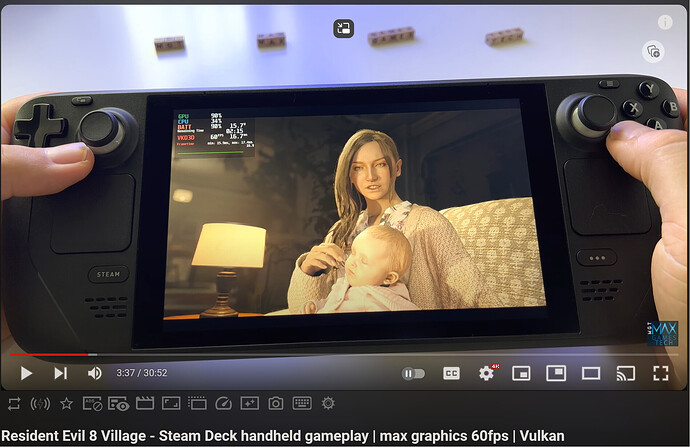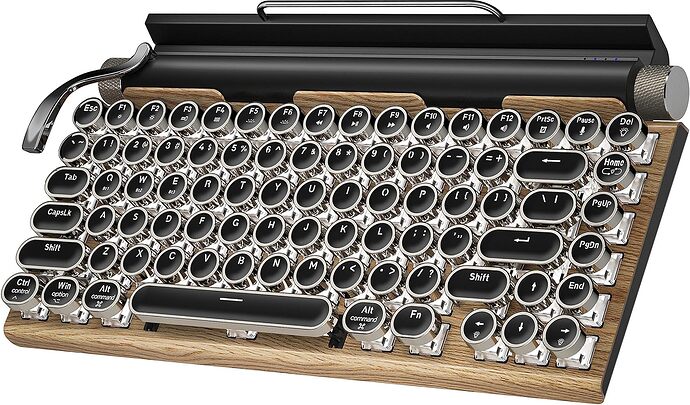Best product: Valve Steam Deck OLED
Sometimes, it is not reinventing the wheel but taking a simple product and rounding off the rough edges of its minor flaws to achieve greatness. The Steam OLED’s magic is raising greatness from an already very good product, replacing its Achille’s heel, a substandard muted sub-sRGB 60 Hz HD LCD display with a beautiful rich and deep 100% DCI-P3 90Hz HD OLED panel, as well as applying a die shrink to its already super-efficient custom SoC and increasing battery size from 40 WHr to 50 WHr to increase battery life by 50%. The results are astounding to the eye and in runtime longevity.
Thanks to these optimizations, the 2.25 to 2.5 hours battery life is now the bare minimum with the Steam Deck OLED, which is up from the 1.5 to 1.75 hours battery life floor of the old Steam Deck LCD, and that is if you game at high settings at 800p. Getting even longer is quite doable with many games now having either community and official Steam Deck optimized settings right out of the gate.
Here’s an example of just how dang good the Steam Deck OLED’s battery life is now. Users can now emulate Switch games sometimes longer than the Switch itself with the Steam Deck OLED which is a testament to how a properly developed handheld SoC can be so efficient. I am playing through The Legend of Zelda: Tears of the Kingdom and I routinely get about 3-4 hours battery life. It can emulate (that’s like running double the laps of your competitors to qualify for the same tournament), emulate, mind you, a current generation handheld, the Nintendo Switch, with roughly equivalent battery life.
From the get-go, Valve made the right moves with the Steam Deck by targeting an HD resolution (1280x800) rather than the overly ambitious full HD resolution of the ROG Ally (1920x1080). Let’s face it, gaming performance is going to be a moving target with each new generation of GPU and games try squeezing more shaders and vertices into a scene, making 720p-800p the sweet spot for a mobile SoC. So by keeping resolution in check, Valve avoided making the modern equivalent of a Sega Game Gear that was notorious for sucking power.
Even Apple’s partners see as much, often targeting a 720p resolution with AAA titles. By comparison, Resident Evil Village on iPhone 15 Pro Max drains at a rate of 10% per 15 minutes, or roughly 2 hours at 1560x720 and 30 fps at the visual equivalent of low settings on PC to boot. Just look how smeared the details are on the iPhone. Exhibits A and B below. As it was, with older Steam Deck LCD at highest settings got 60 fps and 2.5 hours battery life, and the new Steam Deck OLED gets 50% longer battery life, so do the math here (roughly 3.5-4 hours) and you can see how amazing a true and proper handheld SoC from AMD can be–when done right, that is.
Worst product: ASUS ROG Ally
That incidentally brings me to the ROG Ally and the Ryzen Z1 family SoC heart of that device that is a mixed bag. @desertlap, I was also underwhelmed by Ryzen Z1 series and while ASUS did no favors with their rough start from the whole micro SD card reader fiasco, AMD is ultimately the one to blame here. They did the community dirty with that one since the Ryzen Z1 family is no handheld SoC and it shows.
I could complain all day long how ASUS was found by the community to use an improper soldering process with the ROG Ally’s micro SD card controller and how they never came out and came clean about that, blaming heat for what was improper soldering in the factory lifting the controller module off of the PCB. Photographic evidence by myself and others in the ROG Ally Discord server corroborated that the soldering process had been silently rectified in the August manufactured units.
However, the real reason that ROG Ally for me was weak was because it failed to include the necessary power optimizations that AMD and ASUS promised in the Ryzen Z1 family. Instead, from what many people including myself found, the Ryzen Z1 series performed like lower binned Ryzen 7000 processors because, in truth, they were just that: factory rejects of a laptop SoC shoved into a handheld. Z1 Series are Ryzen 7000 rejects with (1) the AI fused off and (2) worse voltage-to-performance than the Ryzen 7000 series.
Really, Z1 Series is a way for AMD to maximize yields by offloading substandard Ryzen 7000 dies into handhelds. That is why even the Steam Deck’s custom processor is more efficient than the Z1 family: there is simply nothing custom or handheld oriented about it other than them being factory seconds. On the other hand, the custom SoC in the Steam Deck was truly custom and not some rejecto-mundo to please investors to increase silicon yields by harvesting and rebadging substandard chips destined for the scrap heap. The Steam Deck’s original 7nm Aerith and its 6nm successor Sephiroth are true fully custom silicon, purpose built from the ground up for handheld operation, and it shows. The Ally’s Z1 series is just a bad retrofitted laptop SoC, making the Ally handheld like any gaming laptop, a wall-hugging appliance, with a design exterior that lies about its true intents, and it stinks.




